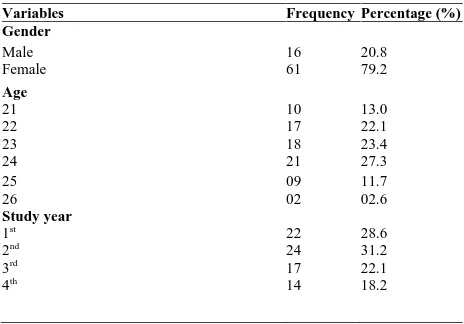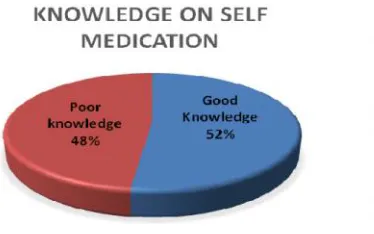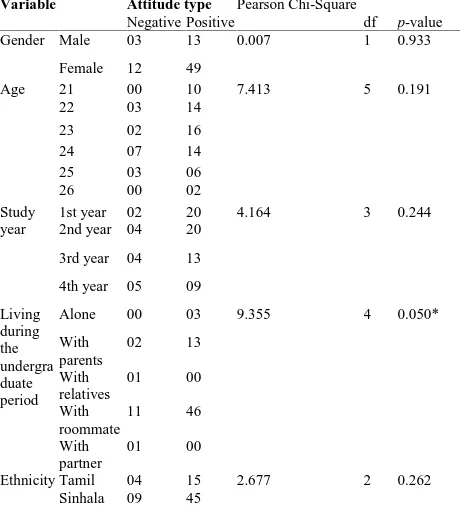DOI:10.21276/ijprhs.2019.01.07
Lokeesan and Laavanya CODEN (USA)-IJPRUR, e-ISSN: 2348-6465
Original Article
Self-Medication Practices among Undergraduate
Nursing Students
V Lokeesan
1,*, L Laavanya
21
Department of Supplementary Health Sciences, Faculty of Health Care Sciences, Eastern University, SriLanka.
2
Department of Nursing, Faculty of Health Sciences, Open University of Sri Lanka.
A R T I C L E I N F O A B S T R A C T
______
1. INTRODUCTION
Self-medication is the use of non-prescribed medicines by people based on their own initiatives. Self-medication is
defined as “obtaining and consuming medication without
professional supervision regarding indication, dosage, and
duration of treatment” 1. The concept of self-medication exists since ages and it is prevalent throughout the world2. Self-medication, as one of the elements of self-care, is the selection and use of medicines by individuals to treat
self-International Journal of Pharma Research and Health Sciences
Available online at
www.pharmahealthsciences.net
Received:29 Jan 2019 Accepted:20 Feb 2019
Introduction:Self-medication, as one of the elements of self-care, is the selection and use of medicines by individuals to treat self-recognized illnesses or symptoms. Studies revealed that there is an increase in trends of self-medications particularly among youth. Hence, there is a need to know the prevalence of self-medication practices among university undergraduate students. Objectives: Aim of this study is to identify the factors and prevalence of self-medication practices among undergraduate nursing students in Eastern University, Sri Lanka. Also, to assess the knowledge and attitude of undergraduate nursing students towards the self-medication practices. Methodology: It is a cross-sectional descriptive study, was conducted among undergraduate nursing students from Faculty of Health Care Sciences, Eastern University, Sri Lanka. Whole population was considered as study samples. A structured self-administered administered questionnaire was used to collect data.Results and Discussion:Most of the participants were using self-medications and the practices. Students gain knowledge on self-medication practices, when their year of study increases. Age and year of study have significant relationship with knowledge on self-medication and its usage. 81% of participants had positive attitude towards self-self-medication and People with whom students are living significantly associated with their attitude.Conclusion:Findings of present study show that majority of undergraduate nursing students are knowledgeable on self-medication practices and they have positive attitude towards the usage and its consequences. Even though, more awareness regarding self-medication practices are needed.
Key words:Attitude, Knowledge, Practices, Self-medication, Students, University.
Corresponding author * V Lokeesan
Department of Supplementary Health Sciences, Faculty of Health Care Sciences, Eastern University, SriLanka
recognized illnesses or symptoms3. Self-medication is like a double edged sword, at one end it helps in reducing the burden over the health care system and thereby reduces the cost of health care4. But on the other end, improper self-medication practices may lead to serious adverse drug reactions5and it may also augment the antibiotic resistance which is an emerging problem worldwide.
Self- medication is widely practiced in both developed and developing countries, especially in developing countries as many drugs are dispensed over the counter without prescription6, 7.As a result, medications may be approved as being safe for self-medication by the national drug regulatory authority. Such medicines are normally used for prevention or treatment of minor ailments or symptoms, which do not justify medical consultation. In some chronic or recurring illnesses, after initial diagnosis and prescription, self-medication is possible with the doctor retaining an advisory role8. Analgesics, antibiotics, and cough syrups are most commonly used drugs without prescription9.
Studies revealed that there is an increase in trends of self-medications particularly among youth. This can be attributed to socio-economic factors, such as life style, ready access to drugs, increased potential to manage certain illnesses through self-care, greater availability of medicinal products, socio-demographic, epidemiological, availability of healthcare and health professionals, law, society and exposure to advertisement, high level of education and professional status4. Self-medication is not totally prohibited and the WHO sets criteria for responsible self-medication as a part of self-care to improve the health care system3. Hence, there is a need to know the prevalence of self-medication practices among University undergraduate students.
There were very limited studies conducted in Sri Lanka. The expected outcome will bring out the factors, which are contributing to take self-medications. Through this study, researchers can identify the factors and prevalence of self-medication practices among undergraduate students in Eastern University, Sri Lanka. Also, researches can assess the knowledge and attitude of undergraduate students towards the self-medication practices. So far, there were only few studies conducted in some other state universities in Sri Lanka. However, there were no any studies performed in Eastern University, Sri Lanka, which leads an urges to this proposed study to identify the Self-medication practices among undergraduate students in Eastern University, Sri Lanka.
2. MATERIAL AND METHODS
It is a cross-sectional descriptive study, was conducted among undergraduate nursing students from Faculty of Health Care Sciences, Eastern University, Sri Lanka. Whole population was considered as study samples. Seventy seven undergraduate nursing students of first year to final year were included in this study as participants. Undergraduate nursing students who were not willing to participate in this
study were excluded. A structured self-administered administered questionnaire was used to collect data. The questionnaire included basic demographic characteristics and living habits of participants, knowledge on self-medication practices and attitude towards self-self-medication practices. Research proposal was submitted to Ethics Review Committee of Faculty of Health Care Sciences, Eastern University, Sri Lanka and ethical approval was obtained. Permission for data collection was obtained from Dean, Faculty of Health-Care Sciences of Eastern University, Sri Lanka. Participants were sensitized thoroughly about the purpose of the study prior to data collection. The written informed consent was obtained from each subject after explaining the procedure, purpose of the study and its benefits. After completion of data collection, the Statistical Package of Social Science (SPSS v.20) was used for entering, analyzing, and interpreting the data. The questionnaires were coded and subjects were identified by numbers, not by their names. Data obtained were kept under lock and key. Privacy, confidentiality and anonymity of subjects were ensured throughout the study. Also participants were informed that they have the right to withdraw from the study at any stage without penalty.
3. RESULTS
Description of Socio-demographic characteristics of participants.
There were 77 undergraduate nursing students participated in this study, among them 61 of them were females. Most of them were 24 years old and 31.2% were in second year. While considering the stay during the study, 74% of participants were staying with roommates. Most of the
student’s parents were earning between Rs.10, 000.00 and
Rs.30, 000.00 per month. Among the study population 70.1% were Sinhalese where 24.7% and 5.2% were Tamils and Muslims respectively. Majority of participants (51.9%) spent 1-2 hours for studying per day. While considering sports, 62.3% of nursing student spent less than 1 hour per day. Around 94.8% of students were not consuming alcohol, where 98.7% were not having smoking habit. (Table 1)
Table 1: Socio-demographic characteristics of participants.
Variables Frequency Percentage (%) Gender
Male 16 20.8
Female 61 79.2
Age
21 10 13.0
22 17 22.1
23 18 23.4
24 21 27.3
25 09 11.7
26 02 02.6
Study year
1st 22 28.6
2nd
24 31.2
3rd
17 22.1
4th
Living during undergraduate period
Alone 03 03.9
with parents 15 19.5
with relatives 01 01.3
with room mate 57 74.0
with partner 01 01.3
Monthly family income
<Rs.10000 06 07.8
Rs.10000-Rs.30000 38 49.4
Rs.30001-Rs.50000 21 27.3
>Rs.50000 12 15.6
Ethnicity
Tamil 19 24.7
Sinhala 54 70.1
Muslim 04 05.2
Time spent for studying
< 1 hour 03 03.9
1-2 hours 40 51.9
3-4 hours 27 35.1
> 4 hours 07 09.1
Time spent in sports
< 1 hour 48 62.3
1-5 hours 22 28.6
6-10 hours 04 05.2
> 10 hours 03 03.9
Alcohol consumption
Yes 04 05.2
No 73 94.8
Habit of Smoking
Yes 01 01.3
No 76 98.7
Types of drugs used for Self- medication
Figure 1 describes about the types of self-medications used by undergraduate nursing students. Among the study population, 16% of them were using Analgesics and vitamin supplements. Creams were used by 14% of participants. When considering the antibiotic usage, 12% of respondents were using. Females consumed most of the Analgesics to get relief from menstrual pain.
Significant factors associated with self-medication practices
Most of the participants (64) were using self-medications and the practices have statistically significant relationship with age. When considering from age of 21 to 24 years old, self-medication usage have rising trend. The year of study, also have statistically significant relationship with self-medication usage. Here, when student learn about drug usages in their degree programme, they know how to use self-medication safely (Table 2, 3).
Fig 1: Types of drugs used for self-medication
Table 2: Association between Self-medication practice and Age
Age Total
21 22 23 24 25 26
Self-medication use
No 2 6 4 0 0 1 13
Yes 8 11 14 21 9 1 64
Total 10 17 18 21 9 2 77
Pearson Chi-Square 12.198139, df5, p- 0.032
Table 3: Association between Self-medication practice and Study year
Study year Total
1st
year 2nd
year 3rd
year 4th
year
Self-medication useNo 10 2 0 1 13
Yes 12 22 17 13 64
Total 22 24 17 14 77
Pearson Chi-Square 18.448, df 3, p-0.000
Knowledge on self-medication usage
When considering the knowledge on self-medication usage, majority of respondents (52%) were having good knowledge where remaining had poor knowledge. This indicates that the participants are knowledgeable regarding the negative impact of self-medication (Figure 2)
Fig 2: Knowledge on self-medication usage
Table 2 describes the factors associated with knowledge on self-medication usage. While considering the gender, half of males had good knowledge on self-medication and its usages; 52.5% of females had good knowledge. When considering the year of study, 81.8% of first year students had poor knowledge, whereas 76.4%of participated students who were in third year having good knowledge on self-medication usage. It clearly shows that, when year of study increases, students gain knowledge regarding self-medication usage. Age and year of study have statistically significant relationship with knowledge on self-medication where other variables have not.
Table 4: Factors associated with knowledge on self-medication Variable Poor
knowledge Good Knowledge
Pearson Chi-Square
d f p-value
Gender Male 08 08 0.030 10.860
Female 29 32
Age 21 08 02 11.654 50.039
*
22 09 08
23 10 08
24 05 16
25 05 04
26 00 02
Study year 1st year 18 04 15.389 30.001 *
2nd year 10 14
4th year 05 09
Living during the under graduate period
Alone 00 03 4.974 40.289
With parents
08 07
With relatives
00 01
With roommate
28 29
With partner
01 00
*p-value<0.05
Attitude towards self-medication usage
Most of the participants (81%) were having positive attitude towards self-medication usage. Which indicate that undergraduate nursing students from Eastern University, Sri Lanka are knowledgeable about process and consequences of self-medication usage (Figure 3).
Fig 3: Attitude towards Self-medication usages
Among the study population, 81% of males and 80% of females were having positive attitude towards self-medication practice. When considering the age, in all age categories, most of them were having positive attitude. Living with during undergraduate period has statistically significant relationship with attitude towards
self-medication. Other variables don’t show any significant
relationship with attitude.
Table 5: Factors associated with attitude towards self-medication. Variable Attitude type Pearson Chi-Square
Negative Positive df p-value
Gender Male 03 13 0.007 1 0.933
Female 12 49
Age 21 00 10 7.413 5 0.191
22 03 14
23 02 16
24 07 14
25 03 06
26 00 02
Study year
1st year 02 20 4.164 3 0.244
2nd year 04 20
3rd year 04 13
4th year 05 09
Living during the undergra duate period
Alone 00 03 9.355 4 0.050*
With parents
02 13
With relatives
01 00
With roommate
11 46
With partner
01 00
Ethnicity Tamil 04 15 2.677 2 0.262
Sinhala 09 45
Muslim 02 02
*p-value<0.05
4. DISCUSSION
In this study, prevalence of self-medication usage among undergraduate nursing student were 83.12% where other studies also found moreover similar prevalence, 76% in Pakistan; 85% in Turkey, 88% in Croatia, 94% in Hong Kong10. Prevalence of self-medication practice has been increasing with year of study, similar trend seen in a study conducted among undergraduate nursing students11. Another study showed that, parental education and professional status was a major influencing factor for self-medication practices12.
The study conducted byHenry James13 among first year medical students found that painkillers were most commonly used followed by antibiotics and fever relieving medicines. Zafar14in Pakistan, Abay15in Ethiopia and Ghosh16in Uttar Pradesh also found that, use of analgesics as self-medication for common conditions in their respective regions. In the current study, analgesics and vitamin supplements were the popular drugs, where cream and antibiotics take second and third places respectively.
Present study reveals that 52% of respondents have good knowledge regarding the adverse effects and consequences of self-medication practices. Even though, the majority of respondents reported this, they are around half of the participants. But another study done in Ethiopia shows that more than 80% of respondents had good knowledge regarding the adverse effects of self medication17. Similar to the present finding, a study conducted in India showed that only half of the respondents were knowledgeable18
Many respondents reported positive attitudes towards self-medication practices in some other studies. For instance, 76.90% of respondents in Bahrain13, 85% of respondents in India19 and 55.50% of respondents in Gondar15had positive attitudes towards self-medication practices. Present study also reveals similar finding, where 81% of participants were having positive attitude towards self-medication usage. According to the current findings, majority of undergraduate nursing students had good knowledge on negative impact of self-medication usage and positive attitude towards its consequences. Even though more awareness is needed for university students, because self-medication is one of the components ofself-care, which is mostly practiced by youth. Adequate awareness will enhance the safe practice of self-medication and will help to free from negative impacts of medicines.
5. CONCLUSION
consequences. Even majority of students are knowledgeable, they are considered as half of the population. It means that, half of the population have not enough knowledge on self-medication practices. Therefore, it is important to provide them more awareness regarding self-medication practices, because they are related to health services and also pioneers who give knowledge and guidance to others in the community.
6. REFERENCES
1. Husain A, Khanum A. Self-medication among university students of Islamabad, Pakistan- a preliminary study. Southern Med Review 2008; 1(1): 14-16.
2. Banerjee I,Bhadury T. Self- medication practice among undergraduate medical students in a tertiary care medical college. West Bengal. J Postgrad Med 2012; 58: 127-31.
3. World Health Organization (WHO). Role of pharmacists in self-care and self-medication. The fourth consultative group meetings on the role of the pharmacist in the health care system organized by WHO in collaboration with the International Pharmaceutical Federation (FIP), Hague 1998; 2-11. Retrived from: http://www.apps.who.int/medicinedocs/en/d/Jwhozip32 e.
4. Alano GM, Galafassi1 LM, Galato D, Trauthman SC. Responsible self- medication: review of the process of pharmaceutical attendance. Braz J Pharm Sci 2009; 45(4): 626-633.
5. Arzi A, Ashtarinezhad A, Sarahroodi S, Sawalha AF. Antibiotic self- medication among Southern Iranian University students. Int J Pharmacol 2010; 6(1): 48-52. 6. Geissler PW, Nokes K, Prince RJ, Achieng RO,
Aagaard- Hansen J, Ouma JH. Children and medicines: Self- treatment of common illnesses among Luo schoolchildren in western Kenya. Soc Sci Med 2000; 50: 1771-1783.
7. Hussain S, Malik F, Hameed A, Ahmad S, Riaz H. Exploring health seeking behavior, medicine use and self-medication in rural and urban Pakistan. South Med Rev 2010; 3(2): 32–35.
8. Partha P, Shankar PR, Sheno N. Self-medication and non-doctor prescription practices in Pokhara valley, Western Nepal: a questionnaire- based study. BMC Family Practice 2002; 3: 17.
9. Afolabi AO. Factors influencing the pattern of self-medication in an adult Nigerian population. Ann Afr Med 2000; 7(3): 120–127.
10. Ali SE, Ibrahim MIM, Palaian S. Medication storage and self-medication behavior amongst female students in Malaysia. Pharmacy Practice 2010; 8(4): 226-232. 11. Souza LAF, Damázio da Silva C, Ferraz GC, Sousa
FAEF, Pereira LV. The Prevalence and Characterization of Self-Medication for Obtaining Pain Relief among
Undergraduate Nursing Students.Rev. Latino-Am. Enfermagem 2011; 19(2): 245-5.
12. Lukovic JA, Miletic V, Pekmezovic T, Trajkovic G, Ratkovic N, Aleksic D, et al. Self Medication Practices and Risk Factors for Self-Medication among Medical Students in Belgrade, Serbia. PLoS ONE 2014; 9(12): e114644.
13. James H, Handu SS, Al Khaja KAJ, Otoom S, Sequeira RP. Evaluation of the Knowledge, Attitude and Practice of Self-Medication among First-Year Medical Students. Med Princ Pract 2006;15: 270–275.
14. Zafar SN, Syed R, Waqar S, Zubairi A, Vaqar T, Shaikh M, et al. Self-medication amongst university students of Karachi: prevalence, knowledge and attitudes. J Pak Med Assoc 2008; 58(4): 214-7.
15. Abay SM, Amelo W. Assessment of self-medication practices among medical and health science students in Gondar University, Ethiopia. J Young Pharm 2010; 2(3):306-310.
16. Ghosh S,Vimal V, Gupta A Chaudhary R. Evaluation of the practice of self medication among college students in west Uttar Pradesh. International journal of Pharma professional research 2010;1(1):14-18.
17. Gutema GB, GadisaDA, Kidanemariam ZA, Berhe DF, Berhe AH, Hadera M.G, et al.Self-Medication Practices among Health SciencesStudents: The Case of Mekelle University. J Appl Pharm Sci 2011; 01(10): 183-189.
18. Uppal D, Agarwal M, Roy V. Assessment of knowledge, attitude and practice of self-medication among college students. Int J Basic Clin Pharmacol 2014; 3: 988-94.
19. Kayalvizhi S, Senapathi R. Evaluation of the perception, attitudeand practice of self-medication among business students in three selected cities, south India. International Journal of Enterprise and Innovation Management Studies 2010; 1(3):40-44.


